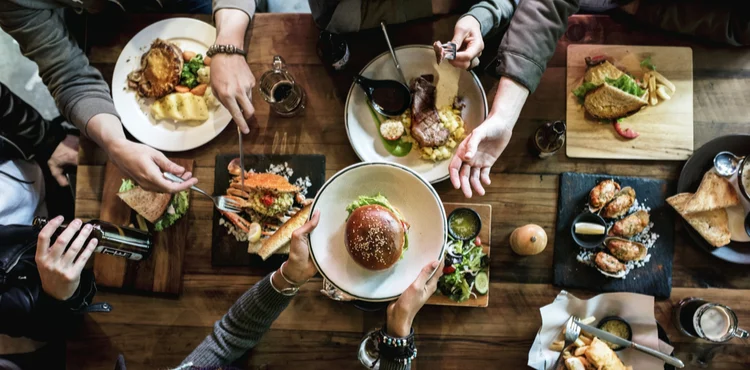
Consumers who dine in public areas must take the bare minimum of safety precautions.
Dining Out
The preparation of meals outside the home, such as at restaurants, hospitals, nursing homes, child care facilities, schools, canteens, airplanes, weddings, business conventions, etc., is one link in the food chain from farm to fork that demands special attention.
Professional chefs and caterers do an outstanding job of safeguarding the public against foodborne illness, especially in light of the large number of meals consumed in such public settings. Even though issues in public areas are extremely rare, when they do arise, they can garner significant public attention. Such crimes are almost always looked into by an official inquiry because they typically have a large number of victims.
Investigations into institutional occurrences have led to initiatives to inform and educate both consumers and professional food handlers to prevent such issues in the future. Such investigations have prompted the establishment of stringent industrial hygiene regulations and, in particular, the Hazard Analysis Critical Control Points (HACCP) system, which is used to guarantee quality in food processing facilities.
Among the unique practices used in public contexts are:
Facilities for hot holding or cooling must be carefully controlled where large quantities of meals are prepared in advance and/or far from the point of eventual consumption, such as in schools, nursing homes, trains, and airplanes, to avoid issues that could lead to people getting ill from consuming contaminated food.
Catering staff should take extra care to prevent contamination when serving meals to big groups of people on lines that are not intended for such volumes.
Professionals in the food service industry confront more difficulties when providing meals on public occasions when the food must both taste well and look creative. If food is decorated with raw ingredients (parsley, shrimp, etc.), it may require more handling than usual to achieve the appropriate finish. As a result, unwanted microorganisms could get into a serving of food that should be safe.
Last but not least, whereas the food manufacturing industry creates a small number of goods using largely consistent processes, food service outlets regularly modify their menus and frequently cook a variety of dishes simultaneously and in the same location.
Professional food handlers should take extra precautions in these situations to prevent cross-contamination between raw materials or between raw food and finished products.
Despite all of these precautions, there remain sporadic cases of foodborne illness that start in public areas. As a result, each consumer has a responsibility to protect himself or herself.
The fundamental guidelines include only consuming food that is scorching hot, rejecting food that has been left out too long, and avoiding food that should be cold but is lukewarm.
Food that appears or smells strange should be avoided, just like at home.
The consumer should look for recognized certificates of good hygiene in public settings because kitchen hygiene is so vital.
An individual with food allergies should exercise extra caution when in public settings and may even want to avoid specific foods unless it is certain that there is no chance of contamination.
Overall, to safeguard people who are more susceptible to foodborne illness, it is especially crucial to pay attention to the evident symptoms of food quality.
Food poisoning poses a greater risk to some persons.
Food poisoning is more likely to affect some persons than others. Their food should be handled with special care. Among the vulnerable groups are:
pregnant women, the elderly, young children, and those suffering from a chronic illness
Barbecues at home and outdoor cooking
Here are some helpful tips for keeping food at home barbecues safe to eat:
Until you are prepared to begin cooking the meat, keep it in the refrigerator.
To prevent cross-contamination of other foods by raw juices, store raw meats and poultry away from cooked foods and below other foods.
Cook meals to a minimum of 75 °C. To determine the final temperature, use a meat thermometer.
The easiest approach to make sure meats are cooked through is to use a thermometer. If you don’t have one, roast poultry until the meat is completely white; pink flesh is not acceptable. Similar to this, cook hamburgers, mince, sausages, and other meats completely until any juices run clear if there is no thermometer.
Never purchase eggs that are cracked or soiled, and always fully cook anything that contains eggs.
Don’t use the same plate or container that previously housed raw meats; instead, use a clean plate for all cooked meats. Never handle cooked food with the same tongs or forks that you used to make raw food.
Tips for general cleanliness
Even though cleanliness is necessary at all times, it becomes even more crucial when you are preparing food away from the house. Be sure to:
Before and after handling raw foods, wash your hands. Use clean water and soap to wash your hands, and then dry them with either clean towels or paper towels.
If there is no safe water, think about using disposable wipes or hand sanitizer. Not all food poisoning-causing bacteria will be eradicated by hand sanitizer. Sanitizer is not preferred for proper handwashing.
Keep the campsite or outdoor space as spotless as you can.
Food poisoning germs can come via birds, insects, and other animals, therefore keep food covered and sealed.
